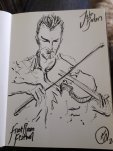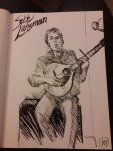Kevan Manwaring's Blog: The Bardic Academic, page 15
July 20, 2020
Awakening the King
Walking the King Arthur Way
[image error]
Completing the King Arthur Way – made it to Glastonbury Tor, July 2020
In 2017 I conceived of a long-distance trail connecting Tintagel in Cornwall (conception place of King Arthur Pendragon, according to legend) with Glastonbury in Somerset (site of Arthur and Guinevere’s ‘graves’, and the Isle of Avalon to some). I intended it as a pilgrimage route, enabling walkers to experience the Arthurian legend in an embodied way, while at the same time reflecting upon, and possibly awakening, their own inner sovereignty – whether king, queen, or other noble archetype. In a world which suffers from many bad leaders, I saw it as a way of empowering positive leadership qualities in oneself. However esoteric or optimistic those goals may seem, I have actualised elements of that in the creation and completion of the King Arthur Way: in its initial vision, research, planning, and instigation. By physically walking the route – with a full forty pound pack, semi-wild-camping along the way – I have led by example. Literally, walked my talk. I know now it can be done. We’re not talking the north-west passage here, of course, but it good to check whether a route is not only viable, but enjoyable – with clearly-marked and passable footpaths, stimulatingly varied terrain, interesting landmarks, fascinating folklore and local history, and practical infrastructure (shops, pubs, campsites, transport links). As with any worthwhile project there was fine-tuning needed. In my first reconnaissance of the Cornish section of the route in late summer 2017, I discovered that trying to include too much was too ambitious. Then I walked from the north to the south coast of Cornwall, covering 60 miles. I found it a slog, with a lot of road-walking and miserable weather. So, I recalibrated the route, generally heading upcountry, in a north-easterly direction – this I found to be ‘easier’ (still an effort, with a full pack, especially on a hot day). I made good progress until a day of relentless rain and hard-walking (roads, urban areas, and the suitably-named Granite Way) gave me a badly-blistered foot. Fortunately, a friend lived nearby and so I appealed to her hospitality and allowed myself a rest day. I hobbled about, and realised trying to complete the rest of the route would be unrealistic. I was faced with a choice: I could abort, and complete it another time; soldier on; or compromise with a shorter version of the route – taking a train between Crediton and Taunton where I had been unable to book a campsite (many had closed for good, or were only taking caravans and motorhomes). I opted for the latter. The prospect of 3 more days wild camping without hot shower, or even a pub to hole up in did not appeal in my weakened state – so skipping those sections was a good idea. Also I booked a lovely airbnb for one night, which was a wonderful halfway ‘treat’. This was, after all, meant to be my holiday – not a SAS training ordeal. Having already walked 60 miles of (an early version of) the route in 2017, plus another 60 ‘extension’ (from my home, near Marlborough to Glastonbury) in June this year, I more than covered the ‘missing’ 40 miles and then some: by the end of the walk I completed 110 miles of the route – with the 2 other sections (60+60), 230 miles, a folkloric wildlife corridor connecting Tintagel to my home in Wiltshire.
There were, as on any long-distance walks, days of real challenge and days of reward. I am still recovering and processing my experience, but some of the highlights include:
Waking up on the coast overlooking Tintagel.
Stumbling upon the ancient rock-cut mazes in Rocky Valley.
St Nectan’s Glen.
Brent Tor.
Wild-swimming in the Tamar, Dart, and Shilley Pool.
Castle Drogo.
Burrow Mump.
Walking to Glastonbury across the Somerset Levels.
I intend to write up the route with accompanying notes, which I may make available as a paperback or pdf download (or both), but for now I have charted the route, so that others may also walk the King Arthur Way if they wish.
KING ARTHUR WAY
Section 1: Tintagel to Wilsey Down (13.66 miles)
https://gb.mapometer.com/walking/route_5116595
Section 2: Wilsey Down to Greystone Bridge (17.07 miles)
https://gb.mapometer.com/walking/route_5116617
Section 3: Greystone Bridge to Lydford (12.96 miles)
https://gb.mapometer.com/walking/route_5116626
Section 4: Lydford to South Zeal (13.04 miles)
https://gb.mapometer.com/walking/route_5116634
Section 5: South Zeal to Crockernwell (12.46 miles)
https://gb.mapometer.com/walking/route_5116643
Section 6: Crockernwell to Sandford (11.87 miles)
https://gb.mapometer.com/walking/route_5116651
Section 7: Sandford to Bickleigh (14.13 miles)
https://gb.mapometer.com/walking/route_5116698
Section 8: Bickleigh to Sampford Peverell (11.91 miles)
https://gb.mapometer.com/walking/route_5116704
Section 9: Sampford Peverell to Taunton (17.36 miles)
https://gb.mapometer.com/walking/route_5116715
Section 10: Taunton to Meare Green* (8.15 miles)
https://gb.mapometer.com/walking/route_5116658
Section 11: Meare Green to High Ham (10 miles)
https://gb.mapometer.com/walking/route_5116663
Section 12: High Ham to Glastonbury (10.87 miles)
https://gb.mapometer.com/walking/route_5116669
Section 13 *alternative across Blackdown Hills, avoiding Taunton (18.97 miles)
https://gb.mapometer.com/walking/route_5116718
[image error]
The start of the King Arthur Way: Tintagel – with the stunning new footbridge, K. Manwaring July 2020
Happy Walking!
Kevan
PS this walk was intended as a group pilgrimage this year, but Covid-19 put paid to that – however, I may lead one in the future if there is sufficient interest.
King Arthur Way Copyright © Kevan Manwaring 17 July 2020
June 28, 2020
June 23, 2020
Pilgrim of Light
Walking the Coast-to-Coast from Robin Hood’s Bay to St Bee’s, Cumbria, Midsummer 2019
I have just returned from a week-long pilgrimage to Glastonbury for the summer solstice – wild-camping along the way and staying with friends. Walking in glorious sunlight (at least for the first couple of days) and holding vigil for the sunrise on the Tor I had plenty of time to think about why I was undertaking such a walk and why the solstice means so much to so many (over 3 million watched the summer solstice sunset and sunrise from Stonehenge online). We live in dark times, and having spent 3 months in lockdown I was desperately in need of a change of scene, and to feel like it was actually summer. I had also finished my teaching for the (very intensive) academic year, and needed a break to mark its end — a hiatus to avoid the relentless monotony that recent weeks have become. However peaceful and pleasant (and productive) the enforced home-stay has been in many ways (especially where I am fortunate to live) the lack of variation in rhythm, in texture, was beginning to feel stultifying. To celebrate the longest day of the year, the joy that summer (usually) brings, and the minor miracle of being (and staying) alive seems like all good reasons to make the effort to witness what of course happens every single day. I have been waking up at dawn lately, and every single time I do and get to eavesdrop upon the dawn chorus and witness the rising of the sun I feel blessed.
Pilgrimage is an act of intentionality, and stopping in a porch in Oakhill to shelter from the heavy rain I was asked by the vicar there, Rev. Richard Priestley, who was just locking up, what I was undertaking mine for. I found it hard to articulate at the time, being soaked and exhausted, but it was, I realised, a journey to the light — a physical prayer to help bring ‘light’ (goodness, peace, kindness, truth) back into the endarkened world. This is not to deny the shadow — we’ve had plenty of opportunity to consider that lately — but to kindle the light that seems so fragile at the moment. On all sides we see how hard-won liberties, and humane values are being torn away or challenged by a disturbing neo-fascist discourse. Those craving power are determined to demonise the marginalised and drive a wedge between communities. It feels like the 1930s all over again. I must admit to being sick to death of social media and the news – I needed a break from it.
Every year around this time I go for a long walk and have a ‘digital detox’. I have walked many of the long-distance national trails in Britain. Last year I walked the 192 mile Coast-to-Coast (or ‘Wainwright Way’) in the north of England, and ended up on an accidental pilgrimage.* That experience made me realise I no longer wanted to do just secular geographical walks — however satisfying they can be — but to have a spiritualised experience. Having a focus, like St Bee’s on the Cumbrian coast (the monastery there celebrates its 900th anniversary this year), with its Midsummer associations (the 9th Century Irish St Bega landed there on Midsummer Eve) transformed my walk into something meaningful. And it was there I decided that this year I wanted to walk a route I had devised in 2017 connecting Tintagel to Glastonbury, a legendary trail in the ‘footsteps’ of King Arthur from the place of his conception to his grave. It felt more powerful to do synchronise this with the summer solstice – as I found that build-up of energy over two weeks really powerful and motivational. It gave one a tangible ‘deadline’ — as though one was racing the sun. Over the winter I planned the route and prepared my pack meticulously. Of course, life is what happens while you’re busy making other plans, as John Lennon wisely sang. Lockdown happened, and even with some easing, all the campsites and pubs remain closed. I was prepared to wild-camp but having nowhere to get a hot shower, charge a phone, or fill up my water bottle (or treat myself to a hot meal and a pint now and then) would make the whole thing more like a SAS training challenge — far too hard-core. It was meant to be my holiday as well, and it is hard to feel very spiritual when you are soaked, chilled, hungry, and exhausted: all you can think about is getting dry, warm, fed, and rested. Also, I didn’t want to risk a 4-5 hour train journey at present. And so I decided to postpone that until it was more viable, and opt for a compromise – a ‘shorter’ walk (1 week, rather than 2) from my doorstep near Marlborough to Glastonbury. It felt like a practical solution that also allowed me to honour the solstice, and scratch my pilgrimage itch.
I have put together this podcast to capture the spirit of my pilgrimage, and to evoke this beautiful time of year. I hope you enjoy it.
The Golden Room episode 12 track-listing
Sunrise Praise – Kevan Manwaring
Reverie pt1 – Rosemary Duxbury (from Thread of Gold)
The Pilgrimage – Sir Walter Raleigh
Reverie pt2 – Rosemary Duxbury (from Thread of Gold)
In the Name of the Sun – Kevan Manwaring
Reverie pt3 – Rosemary Duxbury (from Thread of Gold)
Ascension Day – Henry Vaughan
Reverie pt4 – Rosemary Duxbury (from Thread of Gold)
Adlestrop – Edward Thomas
Drifting By – Fly Yeti Fly
The Green Rooad – Edward Thomas
Serendipity – Simon Andrews
A Midsummer Summoning – Kevan Manwaring
King of the Fairies (trad.) – Shenanigans
The Haymaker’s Song – anon.
The Corn King – Jehanne Mehta
In Love, at Stonehenge – Coventry Patmore
Summertime – Simon Andrews
Praise Song for St Bega – Kevan Manwaring
The Rollright Stones – Jehanne Mehta
Praise Song for a Lost Festival – Kevan Manwaring
Stonehenge – Shenanigans
Pilgrim’s Way – Kevan Manwaring
Salutation to the Sun – Jay Ramsay & Rosemary Duxbury
A Pilgrim’s Joy – Kevan Manwaring
The Faery Beam Upon You – Ben Johnson
Compiled by Kevan Manwaring, 21 June 2020
LISTEN TO THE FULL PODCAST HERE
*My full account of walking the Coast-to-Coast to St Bee’s,’The Accidental Pilgrim’, features in issue 3 of The Pilgrim, available here: https://www.thepilgrim.org.uk/shop
June 22, 2020
The Bardic Path
Follow the Way of Awen
The skills and wisdom of the Bard are as relevant today as they have ever been, in fact, in a world of communication breakdown and collective amnesia – where we fail to honour our geo-cultural heritage, and forget again and again the lessons of the past – possibly more so. The Bard was far more than ‘just’ a teller of tales or singer of songs: he or she was the remembrancer and chronicler for the tribe – of ancient lore, bloodlines, land rites, battles, geasa, great events, important details… In short, their living memory. And furthermore, a celebrant, in an official or unofficial capacity – whose tales and tunes would mark the cycles of life within the circle of the community: the wooings, the weddings, the nativities, comings-of-age, and other thresholds of change. With their words they could bless or blight. Warriors would vie for the honour of being immortalised through their elegies, kings and chiefs would take care to avoid their satire, lords and enemies feared their curses. The system of patronage may no longer be viable, but that also means the Bard is no longer at the behest of a liege. In a world where most forms of communication are monitored, perhaps only the Bard is truly free to speak his or her mind without having to kowtow to so-called ‘political correctness’, corporate values or media fads. In the age of spin, we need more than ever a re-enchantment of language, where people actually mean what they say, free of Post-Modern irony, and a man is as good as his word. It is not a return to spurious ‘old values’ but a re-imagining and renewing of what those values are, by learning from the lessons of the past and acknowledging the perspective which history affords. The wisdom of the past is ever-present, if we but listen. It is an insult to our collective ancestors to do otherwise, for it is their countless sacrifices which have enabled us to have come thus far: to be in this relatively privileged, but precarious, position on the cusp of a new millennia.
In an age of Climate Change and global turmoil, the importance of community, of common people helping one another, having a voice, being heard, validating personal ‘narratives’ outside the hegemony of a grander one, drawing upon their own resources and talents, wealth of experience and motherwit, could never be more imperative. The Bard’s ability to express the inexpressible, to celebrate the lives of all that live and have lived, and preserve for posterity the little epiphanies, personal triumphs and tragedies, heroics and hard-won wisdom from extinction, or from being drowned out in the white noise of endless trivia, enables excellence of expression and freedom of information at a grassroots level beyond webs and nets, dishes and boxes. It offers a folk democracy of the tongue and the limitless possibilities of the imagination.The Bard helps us to celebrate being human and enables us to appreciate other cultures, other perspectives, at the same time as being more fully in our own. It praises the universal through the particular: the local and microcosmic, the parts that make up the whole, which make something bigger than their sum – the biodiversity of humanity.
So, I have devised a 3 year training programme in the belief that everyone can benefit from Bardic skills: either as a listener or performer, whether you only wish to improve your public speaking, entertain your family and friends, or aspire to be a fully-fledged professional Bard, with ‘harp on back’, fire in the head and hundreds of stories at your fingertips. I can claim with complete conviction that you will benefit, however far down the path of the Bard you wish to go, because I certainly have. It has transformed my life: improving not just my communication skills (I never had the ‘gift of the gab’, although I always had a good imagination), but social ones as well (at school I was the introvert wallflower and now, it seems, I can keep most audiences entertained, although everyone has bad days). Becoming a Bard has given me, and is still giving me, so much: it has given me a community and a role to play in it and, perhaps most importantly of all, it has given me a way to live – a true and reliable guide for life.
To summarise: the overall aim of the Silver Branch Bardic Training programme is to empower people to find and use their true voice for the good of all. Its objectives are to:
offer initiation for the budding Bard
provide a practical 36 month training programme
teach the art of storytelling
teach techniques of poetic inspiration, composition and performance
develop the power of the memory
widen understanding of Awen
develop awareness of the Bardic Tradition
explore what it means to be a Bard in the 21st Century
provide resources, such as a reading list, contacts, etc.
connect with the wider community
encourage respect for diverse global traditions and cultures
foster ‘mythic literacy’ and an understanding of mythic levels in modern life
act as a catalyst for new Bardic circles and the re-establishing of Bardic Chairs
facilitate deep study on a myth, legend, fairy tale, or song cycle of one’s choice with critical support & appraisal.
provide critical and creative support for a final project – performance, publication, public event.
An edited extract of the introduction to The Bardic Handbook: the complete manual for the 21st Century bard (Gothic Image, 2006).
[image error]
The Bardic Study series
Silver Branch Bardic Training
A 3 Year Bardic Development Programme
with Dr Kevan Manwaring, (aka the ‘Bardic Academic’), lecturer, author of The Bardic Handbook, and founder of the Silver Branch Bardic Network.
Awaken the Bard within on this intensive 3 year training programme. Each module can be taken individually, at one’s own speed, and is customised to your unique Bardic path. Silver Branch Bardic Training is not a one-size-fits-all course that is set in stone, but is ‘bespoke’: tailor-made to your individual needs and interests. It is delivered by one-to-one mentoring with an experienced, published Bard.
Learn directly from an acknowledged expert in the field: ‘Kevan is a senior Bard in the UK and world landscape and author of the famous Bardic Handbook.‘ (Dr Thomas Daffern)
[image error]
Dr Kevan Manwaring, the ‘Bardic Academic’
Programme of Study
Year 1 – Anruth to Bard (for beginners – no experience necessary)
During this year you shall work through the Bardic Handbook, which sets out a 12 month study programme that will take you from Anruth (apprentice stage) to declaring yourself as a Bard in a dedication and naming ceremony – with direct mentoring from the author himself. Your growing bardic skills will be honed through private study and participation in an online bardic circle.
Year 2 – Bardic Deep Study (Intermediate – for students who have completed Year 1)
With a theoretical focus, this year you will use The Way of Awen: journey of a bard as a guide – which explores the Welsh legend of Taliesin in great detail – but you will be asked to self-select a myth, legend, or song-circle to work on intensively. The fruits of this deep study will be manifold, but will include an extended non-fiction essay reflecting upon the themes of the selected tale/s in a critical way.
Year 3 – Bardic Practical Project (Advanced – for students who have completed Years 1 and 2)
With a practical focus, this final year the Silver Branch: bardic poems will be used as a guide as an example of an approach to an original creative project with a community/ecological aspect. You will conceive and complete a Bardic project of your choice: a spoken word performance, a collection of poems or short stories, an audio recording, a film, a stage play, etc. This final project will be the culmination of your study, which will be launched during an end-of-study celebration, which you will design and organise. This is when you fully step into your role as public Bard, serving your community. Your project will be assessed on not only its originality, skill, and vision, but also how it responds to the challenges of modern life, engages with multimodality or emergent technology, and serves and celebrates community and biodiversity.
What’s included:
Weekly online bardic circle: a chance to raise the awen, connect with fellow bards, and share one’s latest poem, song, or story.
Fortnightly lecture: a talk and connected activity designed to get the awen flowing.
Monthly mentoring session: a chance to ask questions, receive feedback and advice, set one’s goals, reflect upon the previous month, and plan future activities.
Quarterly review: an indepth review to assess progress and plan the next phase of study.
Bardic declaration ceremony: when you received your bardic name and dedicate yourself to the path of the Bard.
Critiques: of your creative and critical projects.
Celebration: for the launch of your graduation project.
In addition:
Year 2: Intensive support and feedback on one’s special study project. Critical appraisal on completion.
Year 3: Editorial support and feedback on one’s special bardic project. Launch celebration.
Fees:
Monthly instalments of £250, or quarterly of £750 by standing order, BACS, or paypal. A discount for full-time students, Senior Citizens, or those in receipt of other benefits is available on application.
Applications open. New term starts in September.
For enquiries: contact Kevan – kevanmanwaring@yahoo.co.uk
21 June 2020
May 20, 2020
Sovereignty, Masculinity, and Hierarchy in Hilary Mantel’s The Mirror and the Light.
 I have just finished reading Hilary Mantel’s magnificent conclusion to her Thomas Cromwell trilogy, The Mirror and the Light, and apart from feeling somewhat bereft (now that I no longer have the double Booker Prize winner’s exquisite evocation of Tudor England to immerse myself in during lockdown) I find myself reflecting upon some of its themes.
I have just finished reading Hilary Mantel’s magnificent conclusion to her Thomas Cromwell trilogy, The Mirror and the Light, and apart from feeling somewhat bereft (now that I no longer have the double Booker Prize winner’s exquisite evocation of Tudor England to immerse myself in during lockdown) I find myself reflecting upon some of its themes.
Sovereignty
The Wolf Hall Trilogy is dominated by two characters – Thomas Cromwell, the blacksmith’s lad from Putney who through his own remarkable intelligence and tenacity, rises to become earl and the monarch’s right-hand man; and Henry Tudor. Their tense friendship I will deal with in the next section, but here I wanted to consider the portrait of sovereignty Henry VIII offers. Far more complex and nuanced than many portrayals of the king over the centuries (in paintings; plays – Shakespeare’s last; novels; films; comic books; ad infinitum, it seems) Mantel’s Henry is intelligent, painfully self-aware, conflicted, and dangerous. The ultimate alpha male in many ways, his unconscionable treatment of his unfortunate (though often equally formidable) wives, heretics, religious real estate, sacred icons, and any one who got in his way or in his bad books, still qualifies him as the villain of the piece. Mantel does not white wash him in the least. And yet Henry’s extreme solipsism and terminally inflated ego – what we might call today a narcissistic personality disorder – is the result of the whole ridiculous edifice of royalty: that is inherent privilege, entitlement, and so-called noble blood. The whole machinery of state, the oil of society, and the sweat of the commoners, supports this invented status – as fictional as anything devised by the best storyteller. For centuries the divine right of kings was a given – to question it was treason, and (very painful) death. Now we still have ‘royalty’, their power often diminished to tokenistic roles, but the creaking institution of monarchy continues. Henry Tudor is a portrait of a man with too much power, whose every capricious whim must be indulged – whose changing moods assail the nation he rules like a tempest. All of his ills are projected onto demonised enemies. Those in favour one week, find themselves anathema the next. Any institution in his way is dismantled. All is fuel to his pyre. In this respect Mantel’s Henry is a portrait with topical resonance. There are many demagogues and tyrants around the world but one in particular stands out. Mantel clearly didn’t write the trilogy as a critique of Trump, but it is hard not to draw a comparison – reading chapters in tandem with seeing the latest insane tweet or briefing from the American president shared all over the news and social media. It is a portrait of how not to be a king, of a kind of anti-sovereignty. Henry Tudor was not a great ruler, because he could not even rule himself. Born to ‘rule’, he is like the classic spoilt child who is never given firm boundaries. Nobody tells Henry what to do. It is ironic that his brother Arthur died young – symbolic in a way of a true portrait of sovereignty, King Arthur: the legendary king of Britain and the epitome of everything Henry was not. In truth, any leader will project our hopes and expectations onto will eventually disappoint. The real sovereignty is found within. Thomas Cromwell, the self-mastered man, found it – and I suspect that is what worried Henry more than anything. His talented servant was more kingly than he ever could dream to be. And Cromwell rose, through his own remarkable merits, to be the most powerful man in England. But of course alpha males cannot accept any competition. And so off with his head.
Masculinity
Although Mantel’s searing portrait of Henry VIII is a masterclass in toxic masculinity, the Wolf Hall Trilogy in its entirety offers many positive portraits of maleness – indeed, although the female characters are significant and often sympathetically wrought (although just as flawed and conflicted as the men), it is the men who dominate the proceedings in almost every way conceivable. The author delights in the company of her male characters and her best dialogue is often in their (private) company – in the intimate exchanges between friends, allies, and rivals behind closed doors. Cromwell’s coterie is lit up by the sparky exchanges between the bright wits and strong personalities of Rafe Sadler, Richard Riche, Gregory his son, Richard his nephew, Christophe, and Call-me-Wriothesley. There is an electrifying jousting of intellect, strategy, and diplomacy between Cromwell and Eustache Chapuys, the ambassador of Spain – one of the most touching friendships in the series (perhaps Cromwell’s only true equal or kindred spirit). Then there are the posturing and jockeying men of the Court – Charles Brandon, Norfolk, Thomas Wyatt; men of the cloth – Stephen Gardiner, Cranmer, Barnes, Cardinal Wolsey (Cromwell’s mentor and a ghostly presence in the last novel), Thomas More (gone but not forgotten); and then the various fathers and brothers, pushing their daughters and sisters forward under the King’s eye, into his bed, hoping for elevation of status. Cromwell is a great patron of the gutternsnipe, the chancer, the cocky lad, and the underdog. He ‘fathers’ them all, and in his way is a good a husband and father as circumstances would allow – until tragedy strikes. The appearance of an unexpected daughter shakes his world – and sense of self-worth – to its foundations. He cannot help but feel a failure, despite all his many triumphs. And yet it is because of this fallibility that we get a rounded, realistic, and affirming portrait of masculinity. Cromwell is far from perfect, but he is a whole man. Over nearly two thousand pages Mantel limns in minutiae the consciousness of a single human being to a dizzying degree, reclaimed and rehabilitated from history.
Hierarchy
Finally, the Wolf Hall Trilogy explores various notions of hierarchy, of hegemonic power structures. These are ultimately what did for Cromwell. In the eyes of the aristocracy he could never quite shake the mud from his boots. Not that he tried to deny his humble origins. Indeed he wears it sometimes as a badge of honour. He is more in touch with the people than the court, certainly than the king. He experiences the full gamut of society. He rises from the open midden of Putney – his face pressed to the cobbles by his father’s boot – to the highest offices in the land. He accrues great wealth, land, titles, and power – but he never ‘lords’ it over anyone; he certainly doesn’t seem to abuse his power. Undoubtedly he had an excellent head for business and prospered accordingly, but one senses this isn’t what was motivating him. Cromwell did not seek to better himself for that reason – but for his own personal development perhaps. To see how far a man could go. And yet his extraordinary progress was ‘vaulting ambition’ to his enemies. The status quo, which maintained the power and wealth in the hands of the few, felt threatened by such advancement. If one commoner could rise so far – then, heaven forfend, others could as well. And that was the one crime the Tudor elite could to countenance. The multiple homicides of Henry VIII and the daily horrors of religious persecution, capital punishment, and extreme poverty, were acceptable. But not social mobility. Cromwell begins the trilogy being brutalised by his father, the thuggish Walter – and ends being crushed by his surrogate ‘bad father’: Henry Tudor. Throughout his time serving the king Cromwell is forced to endure continual threat of execution, unexpected punishment, passive aggression, mockery, and ingratitude. It could be argued that he ‘acts out’ his relationship with his father through his relationship with his king, to whom he becomes a whipping boy, however ‘favoured’. Cromwell is constantly reminded of his place in the pecking order – he is not born into privilege or power or wealth. Henry’s fool, Patch, rudely reminds Cromwell of this – in front of the whole court. When this no longer serves to put the Putney boy, nicknamed ‘Put-an-edge-on-it’, in his place, the machinery of the system grinds inexorably towards its doom: the reaper in the clock, present from the first page, can wait no longer to administer the coup-de-grace.
Ultimately, The Wolf Hall Trilogy offers an unflinching and deeply perceptive insight into human nature. Mantel’s Cromwell is a masterful instauration of one of history’s unflattering characters: Holbein’s ‘heavy’ turns out to be the prototype Rennaissance man. In its scintillating language, its glittering rhetoric, elegant statecraft, profound historicity, and life-affirming connoisseurship of civilisation it is a counterblast to the endemic vilification of the intellectual, the liberal, and the nuanced we face today in public discourse. It is a message in a bottle from four hundred years ago (via a 21st Century mind) of our rare and precious humanity. All that our mercurial human nature is capable of – the very worst and the very best.
© Kevan Manwaring 19 May 2020
The Mirror and the Light by Hilary Mantel (Fourth Estate, 2020)
April 28, 2020
A-Conjuring Summer In
Beltane Fire Society Edinburgh
THE GOLDEN ROOM EPISODE 11
A-Conjuring Summer In
Oh, do not tell the Priest our plight,
Or he would call it a sin;
But–we have been out in the woods all night,
A-conjuring Summer in!
Rudyard Kipling, ‘A Tree Song’
To celebrate May Day, the ancient Celtic fire festival of Beltane which marks the beginning of summer, a merry selection of poems, songs, and field recordings from across Britain – featuring an archive recording from the iconic Padstow Obby Oss celebrations in 1932, the Glastonbury Beltane Celebration, Hastings Jack-in-the-Green, and the Beltane Fire Society of Edinburgh, plus original poetry and folk music. Compiled by Kevan Manwaring.
Track Listings
Dawn Chorus – a English woodland in May, part 1
Padstow Obby Oss (1932) Pathé News
One with the Land – Kevan Manwaring (Silver Branch)
Maypole Song – The Wicker Man (1973)
Beltane Fire Society, Edinburgh, montage
Maid Flower Bride – Kevan Manwaring (Silver Branch)
To Be Unbuttoned – Gabrielle O’Connell
Hastings Jack-in-the-Green (2019)
May Song – Beggars Velvet (1990)
The Winning of Spring – Kevan Manwaring (Silver Branch)
Lass of Islington – trad. David Metcalfe (from ‘Rogues & Ravens’)
The Well – Ella Bloomfield, with drumming by Jay Ramsay (from ‘Phoenix demo’)
Heartwood – Kevan Manwaring (Silver Branch)
Dawn Chorus – a English woodland in May, part 2
River Lover – Gabrielle O’Connell
Glastonbury Beltane Celebration (2019)
Prologue – Jehanne Mehta (words); Fred Hagender (harp) (from ‘Heart of Yew’)
Campfire – Wiltshire downs, late April
Turning the Wheel: seasonal Britain on two wheels by Kevan Manwaring, published by O Books , 2011
Silver Branch: bardic poems published by Awen 2018
With huge thanks to the dedicated and creative communities who have kept the celebrations in Padstow, Hastings, Glastonbury and Edinburgh going all these years. May we gather once again (when it’s safe) to a-conjure summer in.
April 14, 2020
A Sketch in Time – Front Room Festival
On Easter Monday Folk on Foot – a podcast hosted by Matthew Bannister – put together an impressive line-up for their ‘Front Room Festival’ – viewable via Youtube from the comfort of your own domicile. Here are the sketches I made throughout the day. A pleasant way to enjoy a day off.










March 25, 2020
The Green Fuse
THE GOLDEN ROOM EPISODE #10 – THE GREEN FUSE
[image error]
This is a special ‘emergency’ episode of The Golden Room to offer some solace during the COVID-19 global crisis, and to celebrate the coming of Spring. However challenging the current circumstances life continues – and is tangible in every hedgerow, every bird-song, every new bud. This medley comprises my selection of classic poems about the season, along with new work by myself, Ella Bloomfield, and the late Jay Ramsay. Music is provided by Chantelle Smith, Rosemary Duxbury, La Zag, Rick Ward, and Beggard Velvet. May you find this selection soothing. Please pass on to any who you feel will benefit from it.
Track Listings:
THE GOLDEN ROOM EPISODE #10
THE GREEN FUSE
Introduction by Kevan Manwaring/Reverie by Rosemary Duxbury
Lines Written in Early Spring: William Wordsworth
Sumer is icumen in: Anon, 13th anon./voice & harp by Chantelle Smith, 2020
The Trees: Philip Larkin
S.L.: La Zag (from ‘Hic Sunt Leones’)
The Names of the Hare: Translation from the Middle English by Seamus Heaney
Didgeridoo: Sam Bloomfield (from ‘Phoenix’ sampler)
Viriditas*: Hildegard von Bingen
Bright Blue Rose: Marko Gallaidhe (trad.)
Heather’s Spring: Kevan Manwaring
Rosemary Duxbury (from ‘Thread of Gold’)
‘The force that through the green fuse drives the flower’: Dylan Thomas
Oak, Ash, and Thorn: Beggars Velvet (trad. From ‘Lady of Autumn’)
14. When green buds hang in the elm: A.E. Housman
My Bonny Cuckoo: Chantelle Smith (trad., recorded 2020)
Cotswold Love: John Drinkwater
Banjo: Rick Ward (from ‘Keeping the Tradition’)
Spring: Edna St. Vincent Millay
Song Birds: Ella Bloomfield (from ‘Phoenix’)
Lullaby: Jay Ramsay (from ‘Phoenix’)
* Viriditas (Latin, literally “greenness,” formerly translated as “viridity”) is a word meaning vitality, fecundity, lushness, verdure, or growth. It is particularly associated with abbess Hildegard von Bingen, who used it to refer to or symbolize spiritual and physical health, often as a reflection of the divine word or as an aspect of the divine nature.
Selection by Kevan Manwaring 20th March 2018
March 15, 2020
A Man You Don’t Meet Every Day
The Golden Room – Episode #9
Marko Gallaidhe
Listen to The Golden Room with Marko Gallaidhe here
[image error]
Marko Gallaidhe – by Kevan Manwaring, 2018
To get us in the mood for St Patrick’s Day a special archive interview with a man you don’t meet every day – folksinger, musician, magician, and artist, Marko Gallaidhe. Back in 2014 at the start of my doctoral research I recorded a series of wide-ranging conversations with Marko in his flat in Bath. Marko is widely known and respected on the Irish music circuit in Britain, but few people get to discover the depth of his esoteric knowledge. Marko is, I believe, a bona fide tradition bearer with his extensive repertoire and deep understanding of the magical roots of tale and song. I asked questions about the nature of the Sidhe, the Otherworld, and Second Sight – although the conversation went in many fascinating directions. It is the first of what I’ve called the ‘Marko Sessions’, and if there is interest I can make more available.
[image error]
Marko playing a tune – photo by Kevan Manwaring
The tunes (Marko on bodhran, bones, and whistle; John Cunningham on flute) were recorded live at What a Performance! in Bath, on Friday 13th March, 2020. This long-running monthly event was hosted by storyteller Richard Selby, who has kept it going since its founder, Dave Angus, passed away a decade ago.
[image error]
A magician’s rings – photograph by Kevan Manwaring
The research was part of my PhD project at the University of Leicester, which focused on the Reverend Robert Kirk, author of The Secret Commonwealth of Elves, Fauns, and Fairies (1691). We met on Kirk’s birthday, 9th December. The resulting project, a transmedia novel called The Knowing – a Fantasy, is showcased on my website: http://thesecretcommonwealth.com/
[image error]
Marko by Kevan Manwaring
March 1, 2020
A Bardic Year
[image error]
The feast day of Wales’ national saint, St David, seems like an appropriate time to share my bardic plans for the coming year. Having moved to the Wiltshire Downs near Avebury recently I have reconnected to the ancient landscape that first inspired me when I first started to visit the area over thirty years ago. Sacred sites such as Avebury, West Kennet long barrow, Silbury Hill, the White Horse of Uffington, and Wayland’s Smithy cast long shadows in my embryonic imaginarium – and now that I find myself living in their aegis they impress me more than ever with their mystery and longevity, showing a rooted resilience that so much of modern life lacks. Over the last few months it feels like I have been re-membering parts of my lost self – from what I called my ‘Lammas Run’ last August when I revisited the area, reconnecting with friends and the land after half a year living and working in the East Midlands, to this week’s long drive to London to collect ex libris copies of The Bardic Handbook. With cromlechs, sarsens, and barrows on my doorstep, and Avebury itself just an hour’s walk away the ancient mysteries of the ancestors have felt closer than ever – they are part of my daily reality now in a very tangible way. The ghosted downs feel real in a way that modern life often does not. The state of the world leaves me in despair. Like worldly-wise and weary Montaigne the notion of ‘retiring to my estates’ feels increasingly appealing. Of course, I am a mere tenant – just passing through. Although a wise man once said ‘Life is a bridge, cross it but do not build your home upon it.’ This could be an excuse not to commit to anything, not to fully engage, so I would counter-balance that with the words of Bran the Blessed from Y Mabinogi: ‘Let he who is chief be a bridge’. We need good leaders more than ever, not an abnegation of responsibility. The world’s myriad problems need addressing … but we also need solace, we need nurture, and we need sometimes to retreat and replenish our wells. My current home feels like a sanctuary where such things are possible, and from such a place I can offer what I know best: the Way of Awen.
And so to return to my initial statement, here is what I’ve devised for the coming year, bardically (so far)…
BARDIC DIARY 2020
Sat 8th June-Sunday 21st June: King Arthur Way – a summer solstice pilgrimage to awaken your inner sovereignty
Join Kevan Manwaring for two weeks of walking his new King Arthur’s Way, culminating at Glastonbury Tor at the Summer Solstice. He’s devised a new pilgrimage route following the legendary journey of King Arthur, from conception to burial. Ultimately it is about awakening your own inner King or Queen – to find a place at the Round Table, whatever your talents or abilities. No prior knowledge of the legendarium is needed. Find out more and how to book on Kevan’s blog.
Wednesday, 24th June – Brighid’s Flame: A Midsummer’s Dream, 7pm
An enchanting garden concert within the circle of the World Heritage Site of Avebury. All are welcome to an evening of music, storyteller, and poetry with the Wiltshire-based duo, Brighid’s Flame: Chantelle Smith and Kevan Manwaring. There will be a wet weather option in case of inclement weather. The Henge Shop, Avebury, 7pm £5 on door.
http://brighidsflame.co.uk/ www.hengeshop.com/
Saturday, 1st August – The Bardic Handbook book-signing & talk
Meet the author of The Bardic Handbook, Dr Kevan Manwaring, aka ‘Bardic Academic’.
The Henge Shop, Avebury, From 11am in shop; talk on ‘Being a 21st Century Bard’ at 3pm upstairs. www.hengeshop.com/
Saturday, 22nd August – Avebury Bardfest
A day celebrating the vibrant bardic tradition with performances, talks, and stalls. Come and meet the performers in the day in the bardic market, then return in the evening for the concert with a scintillating showcase of the finest storytelling, poetry, and music from bards from near and far. Profits will go to Tree Aid.
Avebury Social Centre. Stalls and talks from noon-5pm; bardic concert from 7pm (£5 on door).
Saturday, 31st October – The Long Woman book-signing & reading
Meet the author of the supernatural novel The Long Woman, Dr Kevan Manwaring, aka ‘Bardic Academic’. The novel is the first part of The Windsmith Elegy (Awen) – a ghost story set in the 1920s, it features Avebury, Glastonbury, Stonehenge, and other sacred sites.
The Henge Shop, Avebury, From 11am in shop; reading/Q&A 3pm upstairs. www.hengeshop.com
Sunder, 20th December – Silver Branch book-signing & reading
Meet the author of Silver Branch: bardic poems, Dr Kevan Manwaring, aka ‘Bardic Academic’.
The Henge Shop, Avebury, From 11am in shop; performance/Q&A 3pm upstairs. www.hengeshop.com www.awenpublications.co.uk
On top of this I have also set up fortnightly ‘Bardic Walks’ from Avebury, starting on 22nd March, and depending on how the Bardfest goes, there are tentative plans to start an Avebury Bardic Circle in the Autumn. Life of course happens while you’re busy making other plans, so it is all in the lap of the gods! All we can do is trust in the awen.
/|\
St David’s Day, 2020



